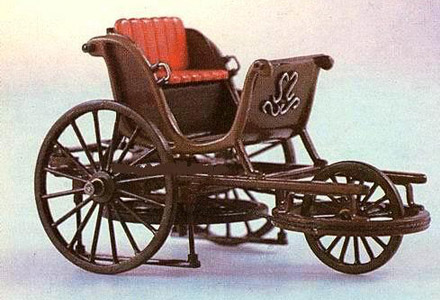 Fifty years later, a skilled mechanic worked at the tsarist court in St. Petersburg, Iwan Piotrowicz Kulibin. Every day he saw magnificent carriages from the window of his room, the famous Russian troika”, and even luxurious carriages drawn by four or six magnificent horses. Kulibin, however, still remembered those poor peasant oxen carts, and even cows, used in the family village, where he came from. So he wanted to deliver a vehicle to his relatives, which would be more handy and would not require a harness. So he constructed in 1784-1791 his famous "Samokatka".
Fifty years later, a skilled mechanic worked at the tsarist court in St. Petersburg, Iwan Piotrowicz Kulibin. Every day he saw magnificent carriages from the window of his room, the famous Russian troika”, and even luxurious carriages drawn by four or six magnificent horses. Kulibin, however, still remembered those poor peasant oxen carts, and even cows, used in the family village, where he came from. So he wanted to deliver a vehicle to his relatives, which would be more handy and would not require a harness. So he constructed in 1784-1791 his famous "Samokatka".
Kulibin's technical solutions resembled Leonardo da Vinci's ideas in many details, although Kulibin never had contact with them and never saw Leonardo's drawings. Nevertheless, he built a kind of two-speed gearbox himself, enabling you to go up a slope and increase speed on a level road. Kulibin also invented the flywheel, which by accumulating the energy of the pedal drive ensured a smooth running of the vehicle. He also applied his idea to new bearings in the wheel axles, based on the rolling bearing principle, which significantly reduced friction. Wanting to improve your vehicle, and not having the means to do so, Kulibin decided to demonstrate “Samokatka” to the tsar and his wife in the hope of receiving an allowance, which would allow further work. The tsar, however, did not like the invention. The only copy of "Samokatka” it covered dust and tangled cobwebs. The vehicle was completely destroyed, but his drawings and calculations survived, now located in the museum, as evidence of the participation of the Russian in the history of the invention of the car. On their basis, a model of "Samokatka”.
Samokatka Kulibina
Visited 122 times, 1 visit(s) today